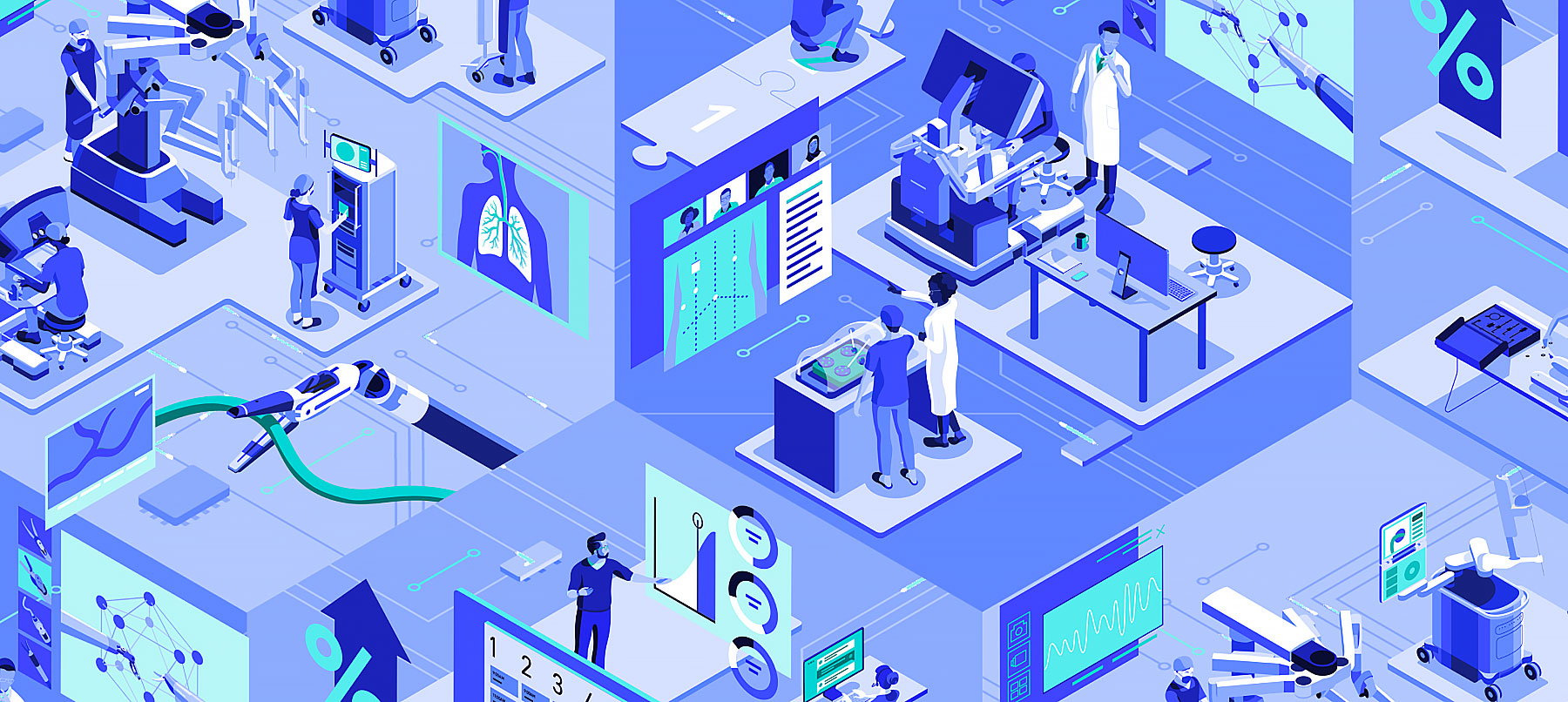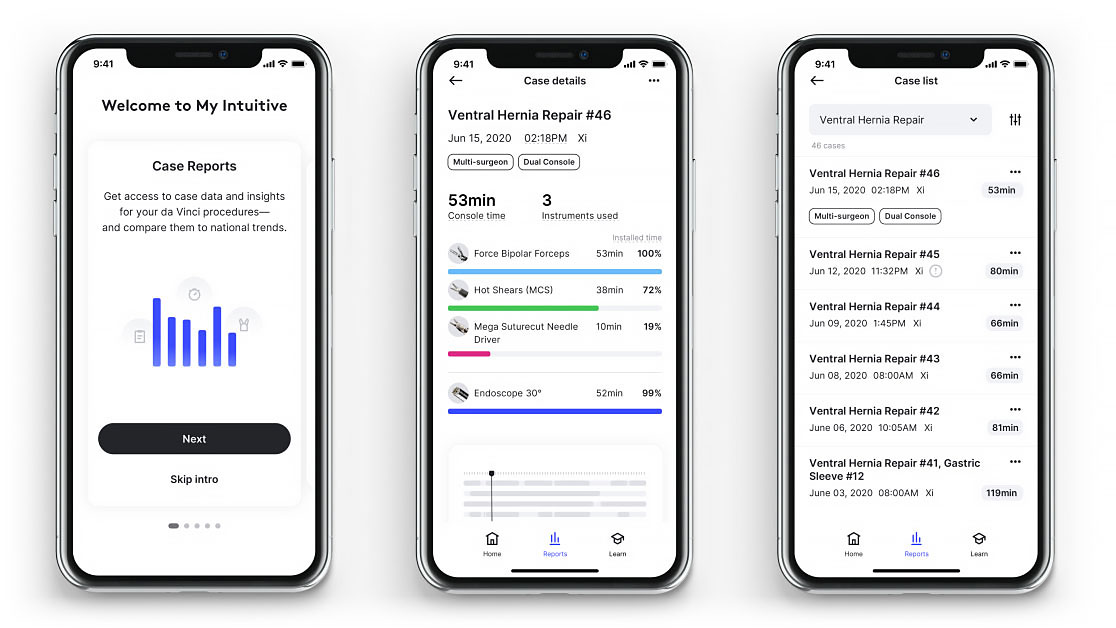

Ankit Patel is a very busy man. As an assistant professor of surgery and director of surgical education at the Emory School of Medicine in Atlanta, he performs surgeries, conducts research, and is responsible for overseeing the training of all of the school’s more than 80 surgical residents. The training program is one of the largest in the country, and at times, it’s been difficult for him to keep tabs on the individual progress of every trainee.
Now he has some help. Last year, Intuitive introduced My Intuitive, an app and desktop program that provides surgeons with a range of detailed metrics on individual robotic surgical performance. He uses it to precisely track each trainee’s individual development in robotic surgery—how much time they’ve spent operating and what tasks they’ve focused on. In the next year, the app will allow him to watch video from his students’ procedures, and assess variables, such as how precise a resident’s movements are during an operation.
“For the first time, we have a digital tool to help with evaluating residents and fellows,” Dr. Patel says. “We have real-time access to their surgeries. It’s objective data rather than subjective. Now we can actually individualize robotic training in a meaningful way.”
My Intuitive is useful in other ways; it also allows surgeons to easily monitor their surgeries and caseloads, giving them a powerful tool with data insights that has the potential to improve their proficiency. “I use it to track my cases,” Dr. Patel says. “I can look at the case log in the app and tell you exactly what happened, based on the data that’s there.”
This is just one of the ways that Intuitive is leveraging the enormous potential of integrated intelligence, using advances in processing power and connectivity to provide actionable data to help hospitals and surgeons better understand and quantify robotic surgical performance.
Intuitive’s latest systems offer digitally enhanced visualization technology, called Firefly fluorescence imaging, which uses near-infrared fluorescence for real-time visualization of blood vessels and lymphatic vessels. In recent years, Intuitive has developed an array of innovations:

On a broader level, Intuitive is also leveraging data to help hospitals improve the effectiveness of their robotic surgical operations, helping to improve clinical throughput and cost efficiency. Intuitive’s Custom Hospital Analytics program helps customers track and analyze a range of clinical, financial and operational metrics. Together, this data can help hospitals and surgeons identify opportunities for growth, efficiency and clinical improvement.
Intuitive is also collaborating with researchers to leverage its enormous trove of surgical data, working to develop a more accurate understanding of the key components of robotic-assisted surgery—what differentiates a complete novice surgeon from one who is a master? The goal is to identify key procedural metrics, and ultimately, to use this data to help surgeons and care teams improve their skills.
Intuitive is still at the beginning of this journey. Every day at Intuitive, engineers, scientists, and clinicians are working hard to develop new ways to realize the incredible promise of minimally invasive care. For instance, Intuitive is working to develop a robust machine learning tool that uses real-time artificial intelligence to help clinicians predict patients’ risk of having surgical complications.
Intuitive has set its sights even higher, envisioning a broad digital platform that gives surgeons an enhanced ability to control and optimize the process of surgery, from patient selection to post-surgical rehab. This multi-faceted digital approach has the potential to help transform the practice of robotic surgery.
Ultimately, this work will help Intuitive achieve the goal that it has had from the outset—helping more doctors and hospitals deliver the right treatment, to the right patient, at the right time.
As Dr. Patel says, “This is only the beginning, there is so much more we can do.”
Look for more Intuitive stories on leadership, problem solving, and impact at the point of possibility™.
Financial disclosure
The independent healthcare professional quoted on this website has received compensation from Intuitive for consulting and/or educational services.
The material presented represents the views, experiences, and opinions of independent surgeons based on their practice and personal experience performing surgery with the da Vinci surgical system. Their experience may or may not be reproducible and is not generalizable.
Important safety information
Serious complications may occur in any surgery, including surgery with a da Vinci system, up to and including death. Examples of serious or life-threatening complications, which may require prolonged and/or unexpected hospitalization and/or reoperation, include but are not limited to, one or more of the following: injury to tissues/organs, bleeding, infection, and internal scarring that can cause long-lasting dysfunction/pain.
Risks specific to minimally invasive surgery, including surgery with a da Vinci system, include but are not limited to, one or more of the following: temporary pain/nerve injury associated with positioning; a longer operative time, the need to convert to an open approach, or the need for additional or larger incision sites. Converting the procedure could result in a longer operative time, a longer time under anesthesia, and could lead to increased complications. Contraindications applicable to the use of conventional endoscopic instruments also apply to the use of all da Vinci instruments.
For important safety information, including surgical risks and considerations, please also refer to www.intuitive.com/safety. For a product’s intended use and/or indications for use, risks, full cautions and warnings, please refer to the associated user manual(s).
Individual outcomes may depend on a number of factors, including but not limited to patient characteristics, disease characteristics, and/or surgeon experience.
Da Vinci Xi/X system
The demonstration of safety and effectiveness for the representative specific procedures did not include evaluation of outcomes related to the treatment of cancer (overall survival, disease-free survival, local recurrence) or treatment of the patient’s underlying disease/condition. Device usage in all surgical procedures should be guided by the clinical judgment of an adequately trained surgeon.
Da Vinci instruments and accessories
It is the responsibility of the owner of the da Vinci surgical system to properly train and supervise its personnel to ensure that the instruments and accessories are properly cleaned, disinfected, and sterilized as required by the user’s manual. Da Vinci products should not be used in a clinical setting unless the institution has verified that these products are properly processed in accordance with the da Vinci system user manual.
Product training
Training provided by Intuitive is limited to the use of the da Vinci surgical system and does not replace the necessary medical training and experience required to perform surgery. The da Vinci surgical system should be used only by surgeons who have received specific training in its use. Before performing any procedure using a da Vinci system, physicians are responsible for receiving sufficient training and proctoring to ensure that they have the skill and experience necessary to protect the health and safety of their patients.